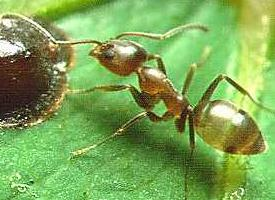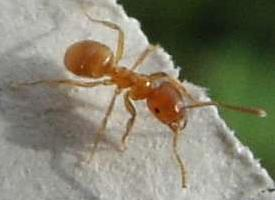
Popis zvířete
The Argentine ant, scientifically known as Linepithema humile, is a small yet remarkably adaptable and resilient species of ant originally native to Argentina, as its name suggests. This species has successfully spread to various parts of the world, including North America, Europe, Asia, Africa, and Australasia, primarily due to human trade and travel. The Argentine ant is recognized for its unique social structure and behavior, which have been pivotal in its success as an invasive species.Characteristically, Argentine ants are small, measuring about 2.2 to 2.8 mm in length. They possess a smooth and shiny body with a color palette that ranges from light to dark brown. Unlike some ant species that exhibit a clear division of worker sizes, known as polymorphism, Argentine ant workers are relatively uniform in size.
One of the most fascinating aspects of the Argentine ant is its social organization. Unlike many ant species that are territorial and aggressive towards outsiders, Argentine ants exhibit a remarkable level of cooperation and tolerance among individuals from different nests. This behavior is part of what is known as "unicoloniality." In their native and invaded ranges, these ants form massive supercolonies, consisting of thousands of interconnected nests and millions of individuals that cooperate, share resources, and even care for each other's young. This social structure allows them to outcompete native species for resources and territory.
Argentine ants are omnivorous, with a diet that includes sweets, oils, and proteins, making them particularly attracted to human food sources. They are known to farm aphids for honeydew, a sugary substance produced by aphids as they feed on plant sap. This mutualistic relationship benefits both the ants and the aphids but can be detrimental to the plants and the ecosystem.
The reproductive structure within Argentine ant colonies is also of interest. Queens are slightly larger than workers and can live for several years, continually laying eggs. The mobility of the colonies is facilitated by the ants' ability to quickly produce new queens and workers, enabling them to spread rapidly and establish new colonies.
However, the success of the Argentine ant as an invasive species comes with significant ecological impacts. Their aggressive competition for resources and territory can lead to the displacement of native ant species and the disruption of local ecosystems. Their presence can also negatively affect agricultural activities, as they protect aphids from their natural predators, leading to increased aphid populations and plant damage.
Efforts to control Argentine ant populations have included various methods, such as chemical pesticides, biological control strategies, and habitat modification. However, their vast supercolonies, high reproductive rates, and ability to adapt to different environments make them a challenging pest to manage.
In conclusion, the Argentine ant (Linepithema humile) is a small yet significant species with a remarkable ability to adapt and thrive in diverse environments across the globe. Its unique social structure, diet, and reproductive strategies have facilitated its spread and establishment in new territories, often at the expense of local biodiversity and human interests. Despite its size, the Argentine ant is a powerful example of how social cooperation and adaptability can lead to dominance in the animal kingdom.
Podobná zvířata
Nové fotografie zvířat
Top 10 zvířat
- Dolphin gull (Leucophaeus scoresbii)
- Diana monkey (Cercopithecus diana)
- Moustached guenon (Cercopithecus cephus)
- Galápagos tortoise (Geochelone nigra complex)
- Japanese macaque (Macaca fuscata)
- Stone loach (Barbatula barbatula)
- Greek tortoise (Testudo graeca)
- Russian tortoise (Testudo horsfieldii)
- Common flying dragon (Draco volans)
- Galápagos penguin (Spheniscus mendiculus)


